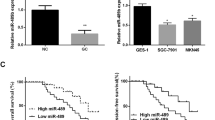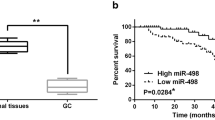Abstract
Background
MicroRNA is essential for the malignant progression of human gastric cancer (GC), which is a leading cause of cancer deaths. However, the mechanism is still not so clear.
Aims
In our present research, we investigated the effect of miR-9-5p in GC.
Methods
We detected miR-9-5p expression in human gastric epithelial cell (GES-1) and GC cells (AGS, BGC-823, MKN-45, and MGC-803), plasma of normal or GC patients, as well as orthotopic xenograft mouse models by real-time PCR. The migration ability was detected by Transwell assays after miR-9-5p mimic or inhibitor transfection in GC cells.
Results
Our results showed that miR-9-5p expression in GC cells and plasma was significantly decreased. miR-9-5p inhibited migration of GC cells by regulating TNFAIP8L3 directly. Low expression of miR-9-5p in GC patients hardly suppressed the migration mediated by TNFAIP8L3.
Conclusions
miR-9-5p, as a potential tumor suppressor gene, is closely related to the malignant progression of GC. Exploring the regulation between miR-9-5p and TNFAIP8L3 may provide a novel strategy for GC treatment.




Similar content being viewed by others
References
Rugge M, Genta RM, Graham DY, et al. Chronicles of a cancer foretold: 35 years of gastric cancer risk assessment. Gut. 2016;65:721–725.
Chen W, Zheng R, Zhang S, et al. The incidences and mortalities of major cancers in China, 2009. Chin J Cancer. 2013;32:106–112.
Cancer Genome Atlas Research, N. Comprehensive molecular characterization of gastric adenocarcinoma. Nature. 2014;513:202–209.
Zamore PD, Haley B. Ribo-gnome: the big world of small RNAs. Science. 2005;309:1519–1524.
Paladini L, Fabris L, Bottai G, et al. Targeting microRNAs as key modulators of tumor immune response. J Exp Clin Cancer Res. 2016;35:103.
Tsai MM, Wang CS, Tsai CY, et al. Potential diagnostic, prognostic and therapeutic targets of MicroRNAs in human gastric cancer. Int J Mol Sci. 2016. https://doi.org/10.3390/ijms17060945.
Liu J, Wang X, Yang X, et al. miRNA423-5p regulates cell proliferation and invasion by targeting trefoil factor 1 in gastric cancer cells. Cancer Lett. 2014;347:98–104.
Shi Y, Chen GB, Huang QW, et al. miR218-5p regulates the proliferation of gastric cancer cells by targeting TFF1 in an Erk1/2-dependent manner. Biochim Biophys Acta. 2015;1852:970–979.
Auer RL. The coming of age of microRNA for B cell lymphomas. Histopathology. 2011;58:39–48.
Huang X, Zhou X, Wang Z, et al. CD99 triggers upregulation of miR-9-modulated PRDM1/BLIMP1 in Hodgkin/Reed-Sternberg cells and induces redifferentiation. Int J Cancer. 2012;131:E382–E394.
Laios A, O'Toole S, Flavin R, et al. Potential role of miR-9 and miR-223 in recurrent ovarian cancer. Mol Cancer. 2008;7:35.
Gao HY, Huo FC, Wang HY, et al. MicroRNA-9 inhibits the gastric cancer cell proliferation by targeting TNFAIP8. Cell Prolif. 2017. https://doi.org/10.1111/cpr.12331.
Jiao G, Pan B, Zhou Z, et al. MicroRNA-21 regulates cell proliferation and apoptosis in H(2)O(2)-stimulated rat spinal cord neurons. Mol Med Rep. 2015;12:7011–7016.
Sugita F, Maki K, Nakamura Y, et al. Overexpression of MIR9 indicates poor prognosis in acute lymphoblastic leukemia. Leuk Lymphoma. 2014;55:78–86.
Han L, Wang W, Ding W, et al. MiR-9 is involved in TGF-beta1-induced lung cancer cell invasion and adhesion by targeting SOX7. J Cell Mol Med. 2017;21:2000–2008.
Zhao P, Wang L, Xiang X, et al. Increased expression of TIPE2 mRNA in PBMCs of patients with ankylosing spondylitis is negatively associated with the disease severity. Hum Immunol. 2017;78:232–237.
Kim BG, Gao MQ, Kang S, et al. Mechanical compression induces VEGFA overexpression in breast cancer via DNMT3A-dependent miR-9 downregulation. Cell Death Dis. 2017;8:e2646.
Lou Y, Liu S. The TIPE (TNFAIP8) family in inflammation, immunity, and cancer. Mol Immunol. 2011;49:4–7.
Goldsmith JR, Chen YH. Regulation of inflammation and tumorigenesis by the TIPE family of phospholipid transfer proteins. Cell Mol Immunol. 2017;14:482–487.
Fayngerts SA, Wu J, Oxley CL, et al. TIPE3 is the transfer protein of lipid second messengers that promote cancer. Cancer Cell. 2014;26:465–478.
Cui J, Hao C, Zhang W, et al. Identical expression profiling of human and murine TIPE3 protein reveals links to its functions. J Histochem Cytochem. 2015;63:206–216.
Acknowledgments
This research was supported by the Youth Research Project of Health and Family Planning Commission of Fujian Province, China (No. 2015-2-48), Natural Science Foundation of Guangdong Province, China (No. 2018A0303130302), Medical Research Fund of Guangdong Province, China (No. A2018011), and Science Foundation for The Excellent Youth Scholars of Jinan University, China (Nos. 89018021 and 21618302).
Author information
Authors and Affiliations
Contributions
WML, GHS, and DYS conceived the project. WML and GHS designed the experiments; YYF, YS, ZHL, XXH, JYL, and WH performed the experiments; and YS and WML wrote the paper.
Corresponding authors
Ethics declarations
Conflict of interest
The authors declare that they have no conflict of interest.
Research involving human participants and/or animals and informed consent
All samples were obtained with patients’ informed consent. The Ethics Committee of Zhongshan Hospital, Xiamen University and The First Affiliated Hospital, Jinan University approved this study. This study does not involve animals.
Additional information
Publisher's Note
Springer Nature remains neutral with regard to jurisdictional claims in published maps and institutional affiliations.
Rights and permissions
About this article
Cite this article
Fan, Y., Shi, Y., Lin, Z. et al. miR-9-5p Suppresses Malignant Biological Behaviors of Human Gastric Cancer Cells by Negative Regulation of TNFAIP8L3. Dig Dis Sci 64, 2823–2829 (2019). https://doi.org/10.1007/s10620-019-05626-2
Received:
Accepted:
Published:
Issue Date:
DOI: https://doi.org/10.1007/s10620-019-05626-2




